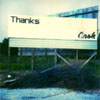 Here at last is a collection of recordings from the 2001 stateside tourof this foursome, all like-minds and prolifics within the vibrantimprov communities of Berlin and Boston. Bhob Rainey and Axel Doernerin particular have emerged as leaders in the extended technique ofbreathy brass playing, where each surface of their horns becomesavailable as an amplified textural playground, as easily hollowed outfor rustling, gaseous overflows as transformed into a turbine ofmagnified industrial clang. Their approach to improvisation means amore acute interaction with the instrument, an inward expansion on thepart of each player that few have been able to jive successfullyagainst the responsibilities of the ensemble setting. Too often theimmaterial (or ultra-material)nature of the style creates barriers between musicians, who are temptedinto layers of colorless ambience or dispassionate exchanges in noise.Even Doerner and Rainey, who maintain astonishing levels of quality inboth solo and group play, sometimes walk into the occasional critiqueof their work as too thin or minimal in its concerns, its dynamics toohidden. These criticisms have no bearing on Thanks, Cash, adisc as sonically dense as anything I've heard from these players, fullof patient, attuned interactions and rich, dark detail. Rainey'sNmperign bandmate Greg Kelley borrows from the bristly, stuntedhalf-blurts of that group's tenser moments, laying down colored accentsand squealing feedback takeovers atop Doerner's closely percussivebreathing exercises and minimal electronic accompaniment. The puretones and static waves of his computer mesh with the ghostlike hover ofAndrea Neumann's innenklavier, producing a painted backdrop ofthrobbing and electric earth tones, a synthetic and darkly greenatmosphere where Rainey's horn hobbles like a wind-tricked door. Hemoves with thrilling impulse from grand, industrial hollows to theclaustrophobic frenzy of spit-soaked insects in the bell of his sax,each sensation delivered with an anticipated and appropriate magnitude.Greater than any one contribution, however, is the ambience of thewhole. The players are less interested in reaction or embellishment aswith a thick textural weave, often achieved as the three horns blend abreathing feedback pattern over Neumann's detached string tangles. Attimes the sound is overpowering and anxious, certainly busier, andtouching harsher extremes than the Nmperign records, but reaching for anew kind of lushness, a forest of electrical fields and buried energy.The four have created a writhing lifeform, nuanced and surprising allat once, and something I can barely imagine witnessing live.
Here at last is a collection of recordings from the 2001 stateside tourof this foursome, all like-minds and prolifics within the vibrantimprov communities of Berlin and Boston. Bhob Rainey and Axel Doernerin particular have emerged as leaders in the extended technique ofbreathy brass playing, where each surface of their horns becomesavailable as an amplified textural playground, as easily hollowed outfor rustling, gaseous overflows as transformed into a turbine ofmagnified industrial clang. Their approach to improvisation means amore acute interaction with the instrument, an inward expansion on thepart of each player that few have been able to jive successfullyagainst the responsibilities of the ensemble setting. Too often theimmaterial (or ultra-material)nature of the style creates barriers between musicians, who are temptedinto layers of colorless ambience or dispassionate exchanges in noise.Even Doerner and Rainey, who maintain astonishing levels of quality inboth solo and group play, sometimes walk into the occasional critiqueof their work as too thin or minimal in its concerns, its dynamics toohidden. These criticisms have no bearing on Thanks, Cash, adisc as sonically dense as anything I've heard from these players, fullof patient, attuned interactions and rich, dark detail. Rainey'sNmperign bandmate Greg Kelley borrows from the bristly, stuntedhalf-blurts of that group's tenser moments, laying down colored accentsand squealing feedback takeovers atop Doerner's closely percussivebreathing exercises and minimal electronic accompaniment. The puretones and static waves of his computer mesh with the ghostlike hover ofAndrea Neumann's innenklavier, producing a painted backdrop ofthrobbing and electric earth tones, a synthetic and darkly greenatmosphere where Rainey's horn hobbles like a wind-tricked door. Hemoves with thrilling impulse from grand, industrial hollows to theclaustrophobic frenzy of spit-soaked insects in the bell of his sax,each sensation delivered with an anticipated and appropriate magnitude.Greater than any one contribution, however, is the ambience of thewhole. The players are less interested in reaction or embellishment aswith a thick textural weave, often achieved as the three horns blend abreathing feedback pattern over Neumann's detached string tangles. Attimes the sound is overpowering and anxious, certainly busier, andtouching harsher extremes than the Nmperign records, but reaching for anew kind of lushness, a forest of electrical fields and buried energy.The four have created a writhing lifeform, nuanced and surprising allat once, and something I can barely imagine witnessing live.Read More

